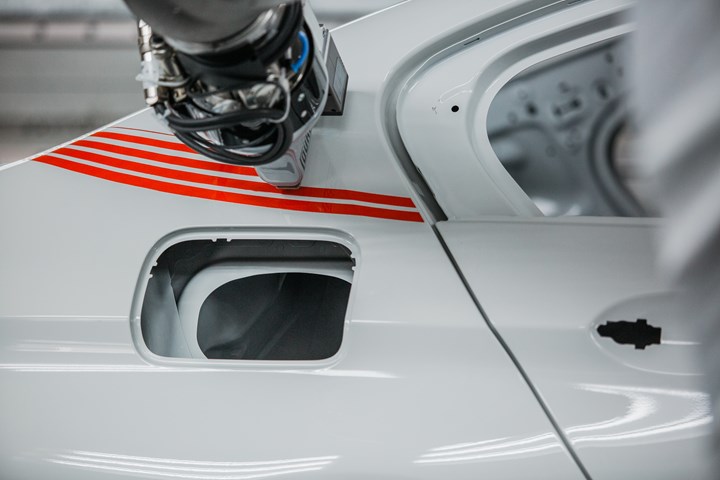
The applicator uses a series of 0.1-mm nozzles to paint. This means precision application of even complex patterns on vertical automotive surfaces.
Photo Credit: Dürr
“Printing instead of spraying is the future of automotive painting.”
Which is a somewhat startling statement as it comes from Dr. Lars Friedrich, President and CEO of Application Technology Dürr Systems AG, and Dürr is well known for its paint systems in the automotive and other industries.
But what Friedrich is talking about is an applicator that the company has developed that doesn’t use a rotary atomizer to apply paint but is based on several dozen nozzles approximately 0.1 mm in diameter that are mounted in a nozzle plate. The nozzles apply paint to the surface in parallel streams from up to 25 mm from the surface. The nozzles open and close independently.
The EcoPaintJet Pro system can apply paint to even vertical surfaces on a vehicle without waste. Because of the precise application of solvent- and water-based 1C and 2C paints — as in there being no overspray — there is no need for masking.
What’s more, the system allows the painting of complex patterns.
Robotic application
The applicator is manipulated with a robot. Robot programming is facilitated by DXQ3D.onsite software. In operation, an initial measurement of the surface to be painted is measured, and should there be a variation between the programmed model and the actual vehicle (due to such things as conveyor or body-in-white inaccuracies), the robot path is adjusted accordingly. To provide more assurance, there is a second sensor on the robot that makes the comparison between the body and the model so adjustments can be made in real-time.
New or existing lines
Dürr has designed the system so that it can be deployed in existing paint operations, as well as new lines, because it is comparatively compact to approaches that require masking for two-tone paint application (i.e., there is no need for the equipment that would apply/remove the masking).
And, of course, there are the environmental advantages associated with the lack of overspray as well as a decreased energy demand, which reduces CO2.
What can’t be overlooked is that the system allows some otherwise hard-to-achieve paint effects on production vehicles.
Related Content
-
Shedding Light on Surface Inspection
State-of-the-art reflector-based lighting system improves luminosity and ergonomics for surface inspection tasks while reducing energy usage.
-
Products Finishing Reveals 2024 Qualifying Top Shops
PF reveals the qualifying shops in its annual Top Shops Benchmarking Survey — a program designed to offer shops insights into their overall performance in the industry.
-
Concrete Reinforced Bars Built to Last
Not all corrosion-resistant materials for infrastructure are created equally. Epoxy-coated steel rebar has advantages that other materials used to prevent corrosion do not.


.jpg;width=70;height=70;mode=crop)











.jpg;maxWidth=300;quality=90)


